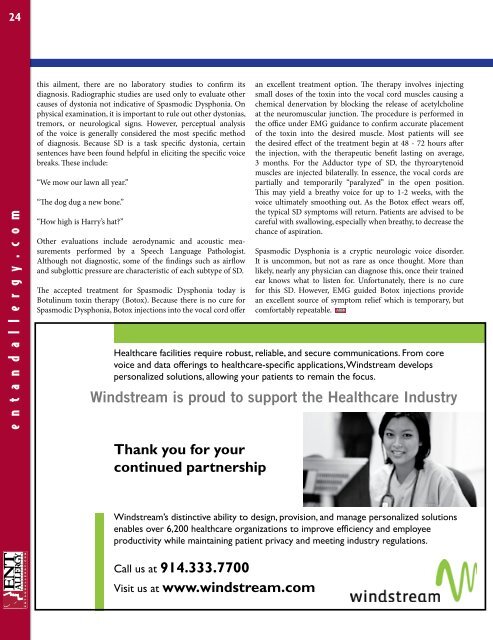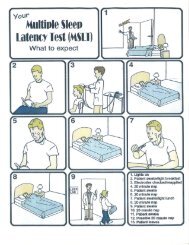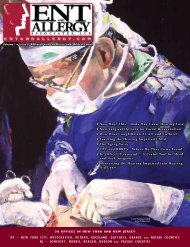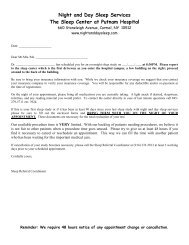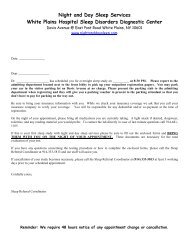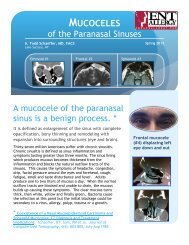ENT and Allergy Magazine Volume I, Issue VIII - ENT & Allergy ...
ENT and Allergy Magazine Volume I, Issue VIII - ENT & Allergy ...
ENT and Allergy Magazine Volume I, Issue VIII - ENT & Allergy ...
You also want an ePaper? Increase the reach of your titles
YUMPU automatically turns print PDFs into web optimized ePapers that Google loves.
24<br />
e n t a n d a l l e r g y . c o m<br />
this ailment, there are no laboratory studies to confirm its<br />
diagnosis. Radiographic studies are used only to evaluate other<br />
causes of dystonia not indicative of Spasmodic Dysphonia. On<br />
physical examination, it is important to rule out other dystonias,<br />
tremors, or neurological signs. However, perceptual analysis<br />
of the voice is generally considered the most specific method<br />
of diagnosis. Because SD is a task specific dystonia, certain<br />
sentences have been found helpful in eliciting the specific voice<br />
breaks. These include:<br />
“We mow our lawn all year.”<br />
“The dog dug a new bone.”<br />
“How high is Harry’s hat”<br />
Other evaluations include aerodynamic <strong>and</strong> acoustic measurements<br />
performed by a Speech Language Pathologist.<br />
Although not diagnostic, some of the findings such as airflow<br />
<strong>and</strong> subglottic pressure are characteristic of each subtype of SD.<br />
The accepted treatment for Spasmodic Dysphonia today is<br />
Botulinum toxin therapy (Botox). Because there is no cure for<br />
Spasmodic Dysphonia, Botox injections into the vocal cord offer<br />
an excellent treatment option. The therapy involves injecting<br />
small doses of the toxin into the vocal cord muscles causing a<br />
chemical denervation by blocking the release of acetylcholine<br />
at the neuromuscular junction. The procedure is performed in<br />
the office under EMG guidance to confirm accurate placement<br />
of the toxin into the desired muscle. Most patients will see<br />
the desired effect of the treatment begin at 48 - 72 hours after<br />
the injection, with the therapeutic benefit lasting on average,<br />
3 months. For the Adductor type of SD, the thyroarytenoid<br />
muscles are injected bilaterally. In essence, the vocal cords are<br />
partially <strong>and</strong> temporarily “paralyzed” in the open position.<br />
This may yield a breathy voice for up to 1-2 weeks, with the<br />
voice ultimately smoothing out. As the Botox effect wears off,<br />
the typical SD symptoms will return. Patients are advised to be<br />
careful with swallowing, especially when breathy, to decrease the<br />
chance of aspiration.<br />
Spasmodic Dysphonia is a cryptic neurologic voice disorder.<br />
It is uncommon, but not as rare as once thought. More than<br />
likely, nearly any physician can diagnose this, once their trained<br />
ear knows what to listen for. Unfortunately, there is no cure<br />
for this SD. However, EMG guided Botox injections provide<br />
an excellent source of symptom relief which is temporary, but<br />
comfortably repeatable.<br />
Healthcare facilities require robust, reliable, <strong>and</strong> secure communications. From core<br />
voice <strong>and</strong> data offerings to healthcare-specific applications, Windstream develops<br />
personalized solutions, allowing your patients to remain the focus.<br />
Windstream is proud to support the Healthcare Industry<br />
Thank you for your<br />
continued partnership<br />
Windstream’s distinctive ability to design, provision, <strong>and</strong> manage personalized solutions<br />
enables over 6,200 healthcare organizations to improve efficiency <strong>and</strong> employee<br />
productivity while maintaining patient privacy <strong>and</strong> meeting industry regulations.<br />
Call us at 914.333.7700<br />
Visit us at www.windstream.com


